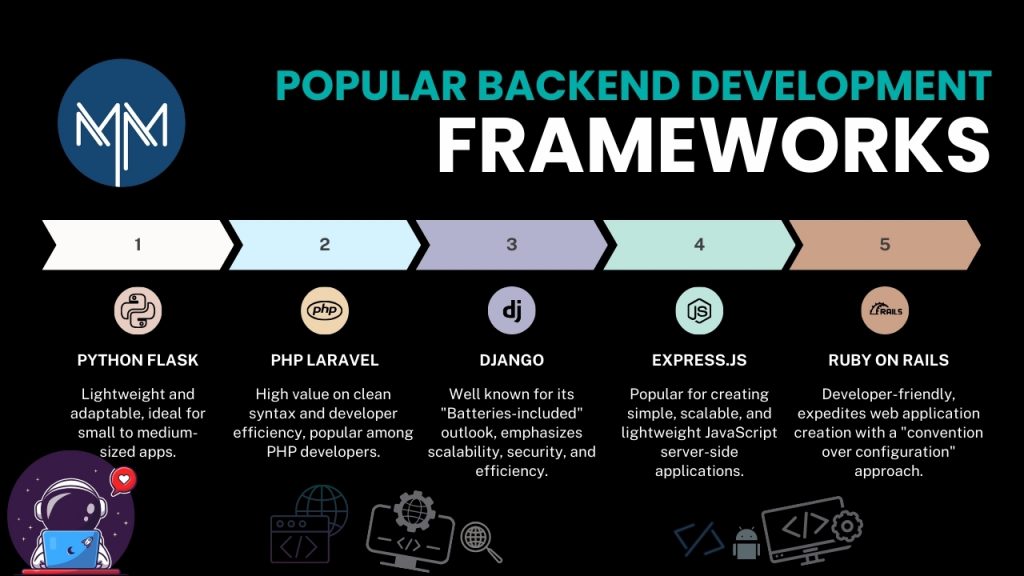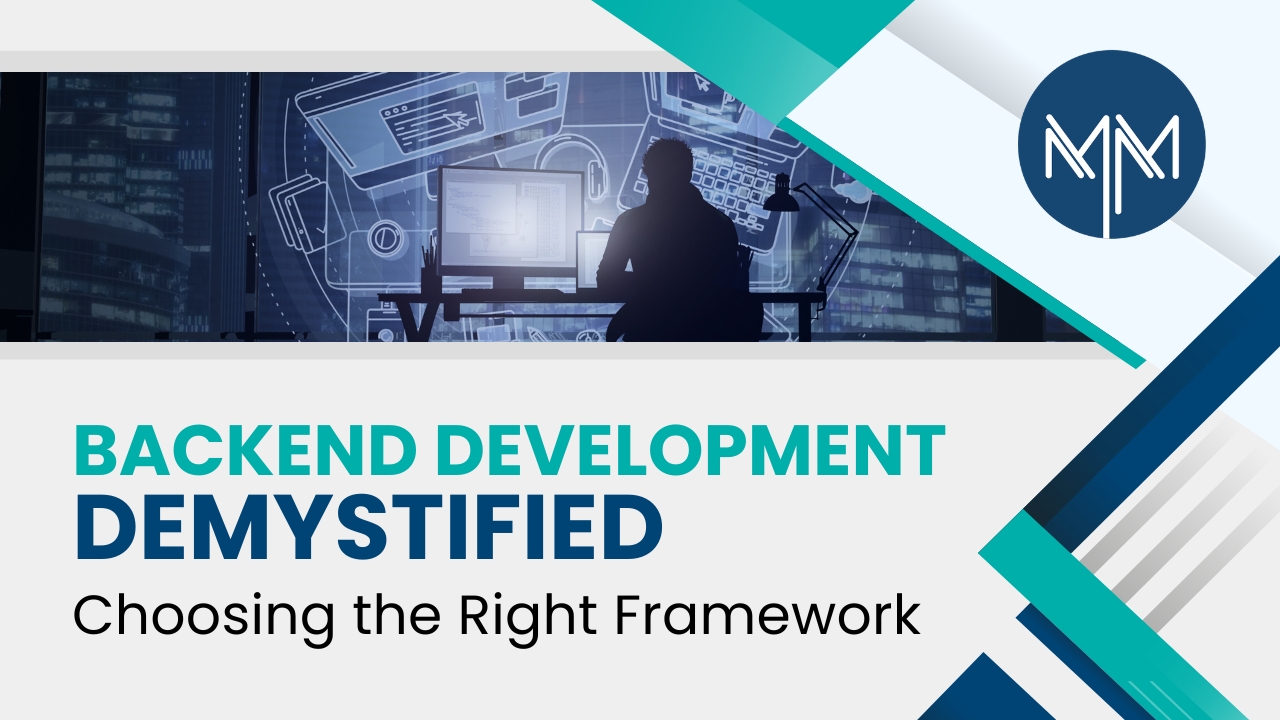At present, the global business scenario is captivated by the buzzword ‘digitalization’. Every type of business irrespective of their margins, has joined its name in the race to become digitalised. The main aim behind becoming digitalized as soon as possible is to get closer to the clients. Henceforth, the role of the website has grown to be a pivotal point within the business culture.
Have you ever wondered why some web applications run seamlessly, while others struggle to keep up with user demands? The answer often lies in the choice of the backend framework.
Beyond The Interface: The Concept Of Backed Development
You can consider backend development as the invisible motor that drives the website. Databases, application architecture, and server-side logic generation are all part of it. To put it briefly, the backend is in charge of managing data, authenticating users, and making sure that the frontend and server are communicating with each other.
Dynamic website capabilities like user account management, data storage, and content delivery are made possible by this behind-the-scenes work. Websites can react to user inputs, handle requests, and present customized information with ease when they have a well-organized backend. Because backend development is the foundation that turns static web pages into dynamic, interactive online experiences, it is essential to the process of creating websites.
According to recent surveys, 80% of developers believe that selecting the right backend framework is crucial for a project’s success. Yet, shockingly, 40% of them struggle with making this decision.

Why do you need the right framework?
Imagine this scenario: you’re a developer tasked with building a robust web application from scratch. You have the vision, and the design, but you’re stuck at a crossroads—choosing the right backend framework. It’s a decision that can make or break your project, much like the story of a developer who chose the wrong framework and faced endless challenges in scaling the application.
Choosing the right backend framework is as important as picking the foundation of a skyscraper when it comes to web development. This decision acts as the cornerstone of your project, supporting server-side logic, coordinating database operations, and enabling smooth frontend and server communication. The backend structure determines how stable and long-lasting your digital creation will be, much like the foundation of a building does. It’s the backbone of your application, responsible for handling server-side logic, and database interactions, and ensuring smooth communication between the front end and the server.
In the ever-evolving landscape of technology, new backend frameworks emerge regularly. Trends such as microservices architecture, serverless computing, and containerization have influenced the development of frameworks. Stay updated with the latest trends to ensure your chosen framework aligns with the current and future needs of your project.
Fear not, for by the end of this blog, you’ll be armed with the knowledge to make an informed decision. We’ll demystify the world of backend development and guide you through the process of choosing the perfect framework for your project.

Key factors to consider while choosing the right backend framework:
- Language Used for Programming: The programming language selection is essential. Every popular language has its own set of frameworks, including Java, Ruby, Python, and JavaScript (Node.js). When choosing a language, take into account the experience of your team as well as the particular needs of your project.
- Community Assistance: A thriving and dynamic community is a reliable sign of a sound structure. Examine online discussions, GitHub repositories, and forums to determine how well-supported a framework is by the community. Continuous updates, problem patches, and an abundance of troubleshooting materials are guaranteed by a strong community.
- Scalability: A framework must be able to evolve with your application. Examine the framework’s capacity for handling more traffic, support for horizontal scaling, and compatibility with scalability-enhancing technologies like load balancers and caching systems.
- Record-keeping: A clear and thorough documentation system is essential while working with backend development. It not only helps new team members get up to speed more quickly but also proves to be a useful tool for problem-solving. Select frameworks that provide copious and up-to-date documentation.
- Features of Security: The first focus should be security. Make sure that the framework complies with security best practices, offers features like input validation, defends against frequent threats (such as SQL injection and cross-site scripting), and facilitates data transport via encryption protocols.
- Database Assistance: The need for databases varies throughout projects. While some frameworks are excellent with NoSQL databases, some function flawlessly with conventional databases. Select a framework based on the requirements of your project and your database choices.
- Performance: Performance is an important consideration, particularly for apps that get a lot of traffic. Analyze the framework’s reaction time, performance, and resource usage. Based on the unique performance needs of your application, benchmarks, and performance testing might assist you in making an informed selection.
A few popular backend development frameworks:
- Python Flask: Flask is a Python web framework that adheres to the WSGI (Web Server Gateway Interface) standard and is lightweight and adaptable. Its simplicity and flexibility make it ideal for small to medium-sized apps.
- PHP Laravel: The PHP web application framework Laravel places a high value on clean syntax and developer efficiency. It is a well-liked option for PHP developers because of its attributes, which include a strong template engine and an expressive ORM (Object-Relational Mapping) framework.
- Django (Python): Django, well-known for its “batteries-included” outlook, makes web development easier by offering a comprehensive set of tools and standards. Due to its emphasis on scalability, security, and efficiency, it is a top option for developers creating intricate applications.
- Express.js (JavaScript – Node.js): Express.js is a popular framework for creating simple, scalable, and lightweight JavaScript server-side applications. It enhances Node.js by enabling programmers to design effective, high-performing web servers.
- Ruby on Rails (Ruby): Ruby on Rails, well-known for its developer-friendly standards and “convention over configuration” tenet, expedites the creation of web applications. It adheres to the Model-View-Controller (MVC) architecture and emphasizes simple coding.

The choice of a backend framework becomes crucial to the success of your project in the ever-changing world of web development. As with choosing the appropriate instrument for the work, a thorough evaluation of several important aspects becomes essential. Programming language development sets the tone, community support guarantees ongoing development and troubleshooting resources, and framework scalability decides how well it adapts to the changes in your project.
Conclusion
In conclusion, thorough documentation becomes the compass in navigating the intricate framework landscape, aiding in efficient implementation. Security features safeguard against potential threats, ensuring the integrity of your application. Compatibility with databases, coupled with optimal performance, guarantees a seamless user experience. By judiciously weighing these aspects, you empower your development team to make an informed decision. In essence, the choice of a backend framework becomes not just a technical decision but a strategic one, shaping the foundation upon which your digital vision stands, poised for success in the ever-evolving realm of web development.
Seek Matrix Media Solutions’ expertise for a smooth and unique web presence that precisely reflects your brand. Our talented backend developers have the know-how to create a custom website that meets your specific needs. We make sure every detail, from complex features to intuitive user interfaces, is in line with your vision.
Don’t settle for less than the best; get in touch with us right now to start building a faultless website that makes an impact. Nothing less than the meticulous creativity of our experienced professionals is appropriate for your brand.


 May 26, 2022
May 26, 2022

